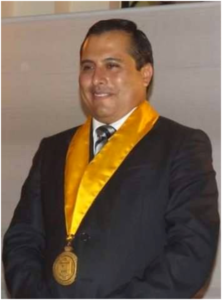Provins
France
Mayor of Rimac District, Peru (October 2016)
Enrique Armando Diaz Peramás

The mayor of the Rimac District in Peru is a lawyer by training and holds a Master of Laws from the University of Lima. He also pursued doctoral studies and a senior management program at the University of San Martin de Porres and the University of Piura, respectively.
He was voted world champion of the United Nations’ City Resilience Profiling Program by the United Nations Secretariat for the International Strategy for Disaster Reduction (UNISDR). In this article, he seeks to communicate the importance of showcasing the city and the citizen, and of promoting the dissemination of the new global agenda for 2030.
1. The Historic Center of Lima was registered on the World Heritage List in 1988. What has been the impact of this nomination for your city?
The initial registration goes back to 1988, but since 1991, the historic centre of the city of Lima has been part of the UNESCO Cultural Heritage of Humanity. Forty percent of this city is under our jurisdiction and this is reflected in the different monuments and the intangible heritage that we possess.
There is no doubt that this contributed to the recognition of our rights in the process of forming my country, Peru: since 1810 and during the design, layout and construction of the city, followed by the era of vice royalty and that of the republic, the Rimac District had always been present.
2. In your opinion, what is the vital role of a mayor when a site has been inscribed on UNESCO’s World Heritage List?
As mayor, my main objective is to showcase, promote and recover major heritage resources that exist in the Rimac District. Being part of the identity of a city breathes life into pride in belonging. This should be encouraged so that everyone becomes involved in the promotion of monuments and their care, as is the case with a heritage home, a home with a garden, a church or, then again, the “Monumental Axis” of our beautiful parkways. Our traditions, music and food are also equally important in contributing to the satisfaction of promoting what we refer to as our “mara ciudad” (old city). Rimac is another Story!
3. Concretely, what have been your actions toward the protection and enhancement of your heritage?
We work on three axes that indicate concretely what we are setting out to achieve:
- Urban renovation and heritage conservation
- Identity, education and innovation
- Formalization, clean-up and resilience
Our approach to the three axes is linear and based on the theme of education as a value for the recovery of the Historic Centre. This is why we opened the Rimac Trades School, a specialized manpower training facility to develop our heritage, with the support of the Spanish Agency for International Development Cooperation (AECID). Likewise, we are developing resilience, which is part of the decision-making aspects of our projects based on risk and disaster management. In this field, we work with USAID, in alliance with COPI, CARE and IRD. As a result, we have been able to begin the transformation of the axis of recovery of our precious heritage in pedestrian zones.
4. Do you hold special events to enhance your city?
In 2016, in the District, we organized the 9th edition of the “Cajoneada” (sound boxes festival), an event that showcases the presence of persons of African descent in the District and acknowledges the District as the first black neighbourhood in the history and establishment of “Malambo”, the original neighbourhood behind the development of Rimac.
We are currently welcoming the travelling exhibition of the Museum of Prado in the course of its tour of Latin America.
5. Has the decision of the Rimac District to promote its status of World Heritage City had an impact on the District?
The impact of the District’s recognition as a member of the Organization of World Heritage Cities has been very positive: the development that we wished to achieve, based on our cultural heritage, has intensified. It has allowed us to hire more managers, in-house and externally, to help showcase the historic city, its monuments, and citizen identity.
6. In your opinion, what makes Rimac District such a special place?
To talk about Rimac in these modern times, I wish to talk first about this ancient city known as “Abajo del Puente” (Under the Bridge). This city, which has the privilege of being situated at the centre of the city of Lima, covers an area of 11 km2 and is home to 200 000 inhabitants. The city dates back to pre-Hispanic times, with “huacas” (pyramids) and the Trujillo Bridge that spanned the Rimac River. Since the vice-royalty era, it has always been inhabited by working class people during the period when my country, Peru, was formed.
Being from “Under the Bridge” is something unique. It is about pride in work, racial blending, tradition and the cradle of the creation of monumental and intangible heritage, and I am proud to be from here. Today, thanks to the efforts of one and all, we are recognized as a World Heritage City.
News
Together towards the New Urban Project
Technical Assistance and Cooperation
Youth and citizens
Communication


